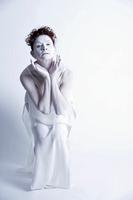Kokoro Dance Theatre Society
"Kokoro" is a Japanese word meaning heart, soul and spirit. When ballet-trained, contemporary dance-formed Barbara Bourget and ski racer and Buddhist scholar Jay Hirabayashi founded Kokoro Dance Theatre Society in 1986 it was with a mandate for cross-cultural exploration and multi-disciplinary collaboration. Since then the company has evolved its own movement language based on the Japanese dance form known as butoh, a serene and brutal post-WWII genre that redefines time and space by rejecting premeditated outward forms and tapping into imagery drawn from the subconscious. Kokoro dancers focus inward and employ intense control to produce singular body images and stage effects, amplified by shaved heads, gnarled hands and feet, and chalky white body makeup.
Bourget has said that she is drawn by butoh's focus on "ma," the space between events. Hirabayashi calls what he does "butoh zen jazz dance." The fusion of these 2 approaches has resulted in prolific creation: the company has produced more than 100 works since its inception, including 40 full-evening staged works. It has toured across Canada, the US and Europe, and performed in a dizzying array of venues, including proscenium theatres, site-specific environments such as streets, parks and beaches, galleries, restaurants and clubs, and at jazz and folk festivals.
Pivotal works created alone and together include Rage (Hirabayashi, 1987), the trilogy Sunyata (Bourget and Hirabayashi, 1991, remounted 1997 and 2006), Crime Against Grace (Bourget, 2001) and Sheepman Dreams (Bourget and Hirabayashi, 2003). In 2005 the company presented Tutaj Tam/Here to There, a collaborative work choreographed in 3 sections by Hirabayashi, Jacek Luminski and Bourget for 12 dancers from Kokoro Dance Theatre and the Silesian Dance Theatre (Poland). Frequent collaborators who have helped to shape the company's aesthetic are composer Robert J. Rosen, lighting designer Gerald King and costumer designer Tsuneko Kokubo.
In 2000 Kokoro launched the Vancouver International Dance Festival (VIDF). The first festival explored contemporary butoh in its many varieties, and included Canadian artists Jocelyne MONTPETIT Danse from Montréal and Fujiwara Dance Inventions from Toronto. The 2001 festival cast its net over the broader field of contemporary avant-garde dance, and the festival has evolved to embrace dance forms from ballet and hip hop to flamenco and contact improvisation. A popular annual event on the Vancouver dance calendar, the VIDF features both ticketed shows and free performances aimed at attracting and growing dance audiences. The 2011 edition of the festival features companies from Germany, Spain, Montréal and Vancouver, as well as the fourth instalment of Kokoro's series of collaborations with the Vancouver Symphony Orchestra.
Kokoro Dance is unusual among Canadian contemporary dance companies in that it trains dancers in its own movement style in addition to choreographing, performing and presenting. Both directors teach, Bourget focusing on technical training within a consistent class structure and Hirabayashi employing a more eclectic approach to integrating technique and improvisation through butoh training.
The company has also performed extensively for young audiences. Its school show The Believer (Hirabayashi, 1995) is a 40-minute dance that grew out of an early signature piece, Rage. Rage exploded with 14 taiko drummers, 3 dancers, a martial artist and a stilt walker in an impassioned polemic on the wartime treatment of Japanese Canadians. The Believer is distilled and concentrated, and comprises a 40-minute dance for 3 performers, a score that includes recorded interviews with Hirabayashi's parents, Gordon and Esther, and a comprehensive accompanying study guide and bibliography.
Kokoro Dance is a uniquely visible dance company in Vancouver, regularly participating in community events such as the annual Powell Street Festival on the city's downtown eastside. Even people who never attend dance performances know about Wreck Beach Butoh, which the company began presenting annually in 1996. Performed by as many as 23 nude dancers at the clothing-optional beach, it has become a signature piece for Kokoro and remains a source of creative inspiration. "It continually reinvigorates us," says Hirabayashi, "and puts us in touch with the earth, air and sea."

 Share on Facebook
Share on Facebook Share on X
Share on X Share by Email
Share by Email Share on Google Classroom
Share on Google Classroom



